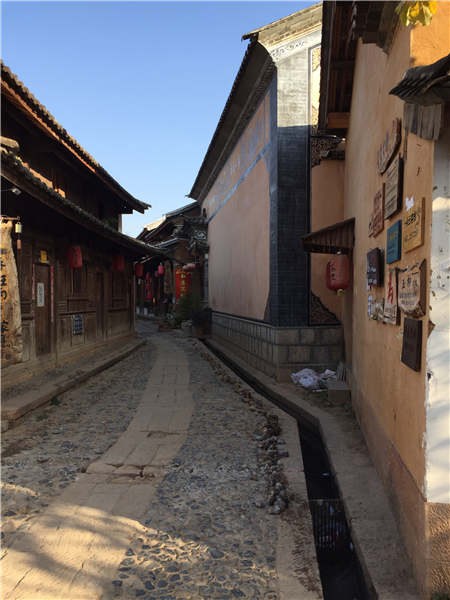A slice of ancient folk culture
Updated: 2016-01-30 07:23
By Yang Feiyue(China Daily)
|
||||||||
 |
|
Shaxi's ancient buildings and street |
Since then, the Swiss Federal Institute of Technology in Zurich has pitched in and worked on the restoration of ancient local buildings.
The efforts have paid off as the restoration now makes the township look like a living museum, reflecting life along the ancient Tea-Horse Road.
The structures featuring red wooden doors and walls and roofs paved with grey tiles from the Ming Dynasty (1368-1644) and Qing Dynasty (1644-1911) are spread in Shaxi.
"The restored buildings are all public property and for the benefit of the public who visit and savor their ancient characteristics," says Pu.
During my one-day stay at Shaxi, the only modern element I saw in the township were some neat-looking boutique hotels and bars with English-Chinese logos and menus, similar to those in Beijing's Nanluoguxiang area.
But unlike the Beijing spot, the inns are thin on the ground.
Pu says that people from across the country, mainly Shanghai, Beijing and Sichuan, have come to set up shop there, mainly small hotels and bars.
But they are mostly found in villages surrounding Shaxi, especially along Sideng Street, so local folk elements and culture are not interfered with, says Pu.
To date, there are roughly 200 such private inns.
Zhou Xiaofen from Taiwan was the first to open a small private inn - 58 Yard - in 2008. Her inn is one of the very few that sit on Sideng Street.
Zhou was drawn to Shaxi by the locals' unsophistication and friendliness.
- Students must learn safety education, experts say
- 73 bodies recovered from rubble of Shenzhen landslide
- Chinese travelers lead 2015 global outbound tourism
- S Korea to issue 10-year visa to highly-educated Chinese tourists
- A glimpse of Spring Rush: little migrant birds on the way home
- Policy puts focus on genuine artistic students
- Negotiating political transition in Syria 'possible': Hollande
- At least three killed in light plane crashes in Australia
- BOJ further eases monetary policy, delays inflation target
- DPRK may have tested components of hydrogen bomb
- Goodwill sets tone at Wang, Kerry's briefing
- Obama picks new Afghan commander

 Djokovic puts down Federer fightback to reach final
Djokovic puts down Federer fightback to reach final
 Treasures from Romania shine in Beijing museum
Treasures from Romania shine in Beijing museum
 First container train links China to Middle East
First container train links China to Middle East
 'Monkey King' performs dragon dance in underwater tunnel in Tianjin
'Monkey King' performs dragon dance in underwater tunnel in Tianjin
 The odd but interesting life of a panda breeder
The odd but interesting life of a panda breeder
 Top 10 best selling cars on Chinese mainland 2015
Top 10 best selling cars on Chinese mainland 2015
 Warm memories in the cold winter
Warm memories in the cold winter
 The world's highest library
The world's highest library
Most Viewed
Editor's Picks

|

|

|

|

|

|
Today's Top News
National Art Museum showing 400 puppets in new exhibition
Finest Chinese porcelains expected to fetch over $28 million
Monkey portraits by Chinese ink painting masters
Beijing's movie fans in for new experience
Obama to deliver final State of the Union speech
Shooting rampage at US social services agency leaves 14 dead
Chinese bargain hunters are changing the retail game
Chinese president arrives in Turkey for G20 summit
US Weekly

|

|








